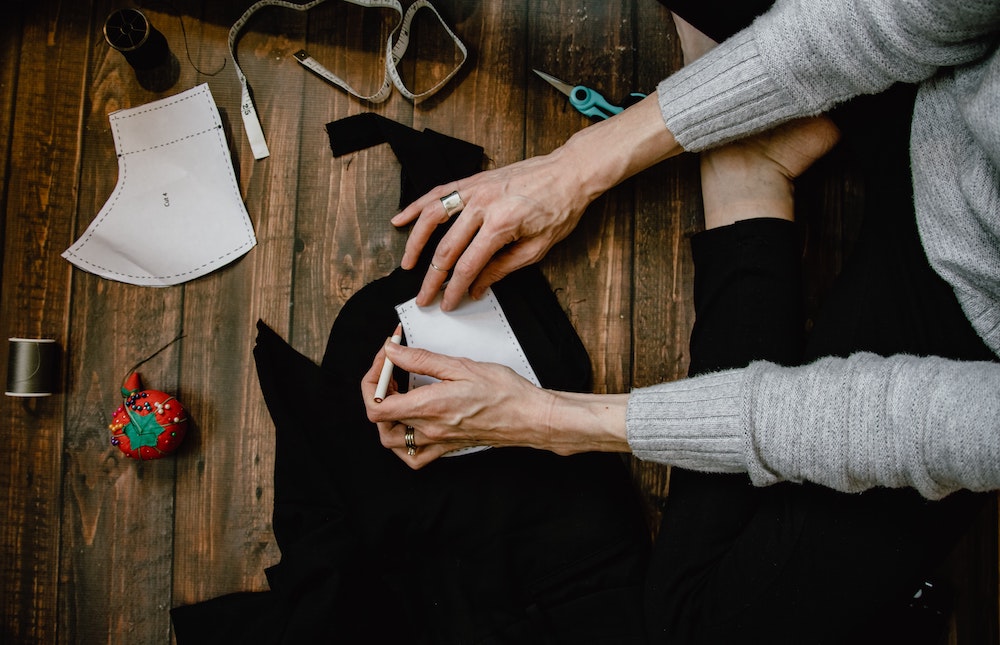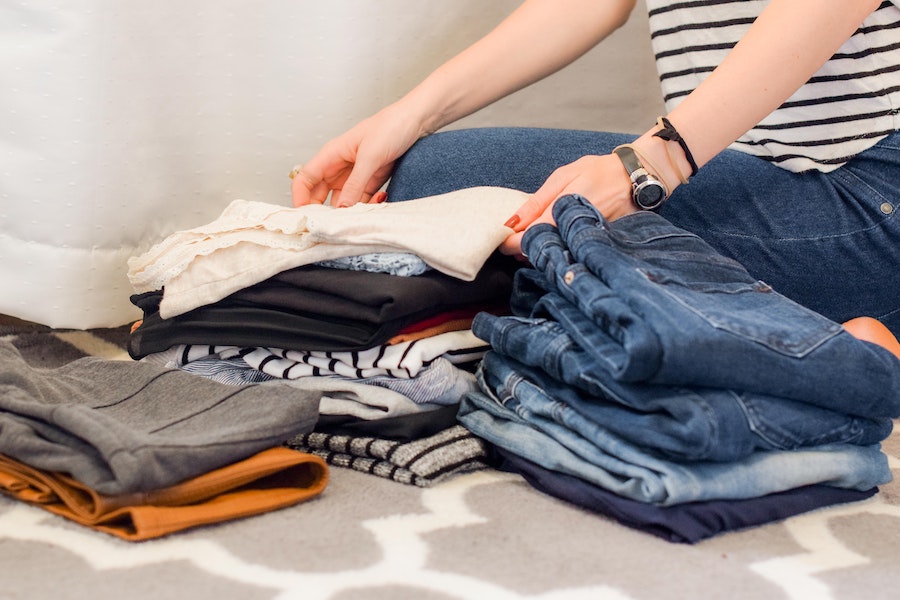Circularity in the fashion industry can be explained as a model where the production of an item is as important as its end of life. To create circular fashion, we must take into account how and with which materials the clothing was made to be able to reuse and recycle it at the end. Next to that, designing out waste and pollution is essential.
Overall, the focus is on changing the linear model to a circular one which is based on the longevity and life cycle of our garments.
What is the advantage of circular fashion over linear?
Nowadays being on trend is often more important than the quality and durability of a garment. This results in items being thrown away or donated when no longer wanted. The issue with those two options is that the clothes do not get recycled or reused but mostly end up in landfills. The circular model has at its core that there is no need to create new materials or clothes. It is all about reusing what we have already created.

How do you make fashion circular?
Here are five steps fashion producers can incorporate into their production to go towards circularity in their company.
- Using little different materials and accessories to produce one item to insure easier recycling and reusing.
- Removing non-recyclable materials from the supply chain.
- Designing out cut-out waste or catching it for recycling.
- Ensuring recycled materials don’t lack in quality for further reuse.
- Throwing away any unavoidable waste accordingly.
Why is a circular economy important in fashion?
“The future of fashion is circular. It has to be.” – Stella McCartney. We use up enormous amounts of raw materials daily. This issue not only concerns the fashion industry but our whole idea of life as those issues do not arise from our basic needs like food and shelter but mostly from our “need” for luxury and excess.
Our mindset of unregulated consumption has to change to an appreciation for our planet and its resources. A shift to a circular model in the fashion industry would result in:
- Reduced dependency on imported raw materials.
- Creation of eco-friendly industries and jobs.
- Eco-friendly brands becoming the norm.
- Reduction in environmental damage caused by resource extraction.
But often this is said easier than put into practice.
Difficulties of the circular fashion industry:
What are the obstacles when moving towards a circular fashion industry?
- Dependency on the consumers’ actions.
- Creating a new business model based on recycled goods is tough.
- The entire cycle requires integrating the product life cycle from raw material to disposal.
Once a mindset change for consumers as well as for businesses towards more sustainable practices happened. Loads of opportunities open up.
Opportunities of the circular fashion industry:
What possibilities open up when adopting a circular economy in fashion ? We’ve summarised some of them here:
- Circular fashion enhances collaboration instead of competition.
- Businesses and people working in sustainable fashion can create ripple effects to inspire others.
- Resources & energy are saved.
- One of the most polluting industries in the world moves towards greener practices to reduce carbon emissions & water consumption.
- Less clothes end up in landfills. INstead they can be recycled, repaired or reused.
And there are so many more opportunities. But how can we as individuals create a positive impact for the fashion industry? Read on and learn more about how you can do your part.
How can you as a consumer help the fashion industry become circular?
There are many alternatives to fast fashion. Consumers can choose to opt for those instead of unethically produced fast fashion garments which probably won’t last a long time.
Here are five tips on what you can do to support a circular fashion future
- Buy less and better quality.
- Shop second-hand clothing instead of always new.
- Take care of your clothes to make them last longer.
- Look for sustainable materials when buying your items.
- Support small, ethical, sustainable and circular brands.

Which brands use circular economy?
Next to small start-up brands which are based on sustainable and circular business models, also big companies are switching to circular based productions. Those big players are the ones with the most impact and which create the most waste. Which makes it essential for those brands to thrive for a circular future.
Two of these big companies in the fashion industry are Adidas or Inditex. They signed a commitment to improve on those four action points:
- Implementing design strategies for cyclability.
- Increasing the volume of used garments and footwear collected.
- More garments and footwear resold.
- Increasing the share of garments and footwear made from recycled post-consumer textile fibres.
What do big brands in the fashion industry do to be more circular ?
Adidas for example uses a 3 Steps Loop Strategy, whereby Step 1 is using recycled materials, Step 2 is making those recycled materials part of a loop that you can use over and over again and Step 3 is to bio-fabricate or engineer the materials of the future so when they come out of the loop, they are biodegradable and can go straight back to nature without harming it. Although these practices are very advanced and will need time to be fully integrated, it is great to see the big players care for a circular economy that won’t harm our planet.
Is a circular economy in fashion realistic?
If we keep on exploiting resources as we do now, by 2050 we would need the resources of three Earths, therefore a circular economy in many industries is definitely a great vision and a goal we should aspire to. But as the circular model has as its core that waste is designed out of the products, this is not possible for the whole of our economy. Still, regarding the fashion industry it might be a far-fetched goal but for sure a realistic and very much needed one.
How can you put circular fashion into practice as a business?
There are loads of opportunities that businesses can put into practice to support circular fashion. Second hand shops increase the lifetime of clothes, online second hand shopping facilitates buying pre-loved items and repairing & using natural materials has various environmental benefits.
Second hand fashion
Pre-owned fashion has become a big trend in the last few years. But different to fast fashion trends which seem to change every month, the trend of second hand clothes is contributing to an improvement of our world’s state. Buying only second hand as a consumer is neither feasible nor realistic. But as long as people consciously choose to not buy fast fashion but from second hand stores or sustainable brands, we can build the perfect base for an environmentally friendly clothing consumption.
Online second hand fashion
Second-hand is definitely not a brick and mortar concept anymore. In a world of fast evolving digitalisation pre-loved garments can easily be sold online. This development makes circular fashion available to the majority of people.
For example Zalando has found a way to offer a new second-hand shopping experience, whereby both the seller and customer can benefit from. Nevertheless, it is still a big conglomerate doing what they do best – making money. It is on you to decide if you prefer a seamless shopping experience through companies like Zalando, Zircle or take a chance at buying from private vendors. Regardless of how, buying pre-loved clothes is a great way to help our fashion industry become more circular and the earth will appreciate your effort.
Repair culture in fashion
Repair has become a buzzword in the fashion industry & resembles innovation in the fashion industry. This is a very important transformation that is essential when loving and wearing our clothes more often and for a longer time.
Hubs like denim city offer repairs and offer the possibility to anyone interested to fix their garment. Nevertheless, one issue does arise. If we continue buying from fast fashion brands, repairing is often not possible as the quality of both the fabric and construction is very poor. If consumers choose to pay extra for well produced garments they might as well be more careful with handling them and willing to repair the clothing if damaged.
In Conclusion, a repair culture within the fashion industry could be a great initiative if we learn to appreciate our clothes more and give them longer lifetimes.
Circular Textiles
A circular fashion industry is strongly dependent on the change to circular textiles. Textiles that don’t shed microplastics nor that are not recyclable. Although the fast fashion industry claims to work in the right direction, recycled polyester is not the solution. Many natural fibres do not compromise the health of our earth. Still, those are of course more expensive than the unbeatable polyester fibre. As Charlotte Borst, Innovation Associate at Fashion for Good said, without legislation challenging companies to take responsibility for the entire product life cycle by using circular textiles, there is a lack of pressure to create a fully circular industry. But with many innovators and people willing to make change happen. We are optimistic that the use of circular textile will become a common practice.
Sustainable fashion brands
Producing circular fashion is a very hard, complicated and expensive task but for sure doable as Patagonia and Ecoalf show. Changing the fashion industry is without a doubt dependent on both the companies and the consumer. There is no way that only one of them changes as the two are so interconnected. Brands like Patagonia and Ecoalf offer sustainably produced fashion but of course this has a higher price tag. Therefore Mirjam and Monica hope for a change in customers mindsets. So, we can work towards a circular future in the fashion industry.
Circular fashion vs. sustainable fashion
What is the difference between circular and sustainable fashion?
Circularity implies that a garment is kept in a cycle by reusing, recycling, repairing, upcycling, donating or other forms of circular practices that will keep materials within the loop. This means that no new resource extraction is required.
While sustainable fashion business models focus more on an environmentally friendly way of producing and extracting. It aims at minimising toxic and harmful ways of producing fashion.
Clothing recycling
Recycling in the fashion industry has become more common in recent years. Most people connect those often not so visually attractive clothes containers with it. But where do those recycled clothes actually go and how are they beneficial to the environment? Stay tuned ! We’ll soon publish a blogpost about it.
Conclusion
Changing an established model like our linear fashion industry into a circular one is one hell of a job. But definitely, one that needs to be done and with the right innovations and open-minded people a task that we can achieve.
To reach our goal of a circular industry, we need to keep in mind that there is not one solution we should strive towards. There are many small ones that can make a difference if we use them together. Both companies and customers are responsible for the fashion industry and the way it operates. But with these many options customers have when it comes to buying more circular, it should be possible for both the consumer and the businesses to find a balance between demand and supply in a sustainable manner.
Let’s work together to achieve our goal of a circular world ! Leave us a comment or contact us for more information.

Pingback: Online Second-Hand Shopping - Wegozero